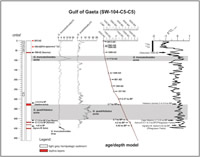Late Holocene forest dynamics in the Gulf of Gaeta (central Mediterranean) in relation to NAO variability and human impact
Di Rita F., F. Lirer, S. Bonomo, A. Cascella, L. Ferraro, F. Florindo, D.D. Insinga, P.C. Lurcock, G. Margaritelli, P. Petrosino, R. Rettori, M. Vallefuoco, D. Magri (2018).
Quaternary Science Reviews, 179, 137-152.
Abstract
A new high-resolution pollen record, spanning the last five millennia, is presented from the Gulf of Gaeta (Tyrrhenian Sea, central Italy), with the aim of verifying if any vegetation change occurred in the central Mediterranean region in relation to specific well-known global and/or regional climate events, including the 4.2 ka event, the Medieval Climate Anomaly (MCA) and the Little Ice Age (LIA), and to detect possible vegetation changes related to still under-investigated climate signals, for example the so-called “Bond 2” cold event around 2.8 ka BP. The vegetation dynamics of the Gaeta record shows a recurrent pattern of forest increase and decline punctuating the mid- and late Holocene. When the timing of these patterns is compared with the climate proxy data available from the same core (planktonic foraminifera assemblages and oxygen stable isotope record) and with the NAO (North Atlantic Oscillation) index, it clearly appears that the main driver for the forest fluctuations is climate, which may even overshadow the effects of human activity. We have found a clear correspondence between phases with negative NAO index and forest declines. In particular, around 4200 cal BP, a drop in AP (Arboreal Pollen) confirms the clearance recorded in many sites in Italy south of 43°N. Around 2800 cal BP, a vegetation change towards open conditions is found at a time when the NAO index clearly shows negative values. Between 800 and 1000 AD, a remarkable forest decline, coeval with a decrease in the frequencies of both Castanea and Olea, matches a shift in the oxygen isotope record towards positive values, indicating cooler temperatures, and a negative NAO. Between 1400–1850 AD, in the time period chronologically corresponding to the LIA (Little Ice Age), the Gaeta record shows a clear decline of the forest cover, particularly evident after 1550 AD, once again in correspondence with negative NAO index.
https://www.sciencedirect.com/science/article/pii/S0277379117305929


